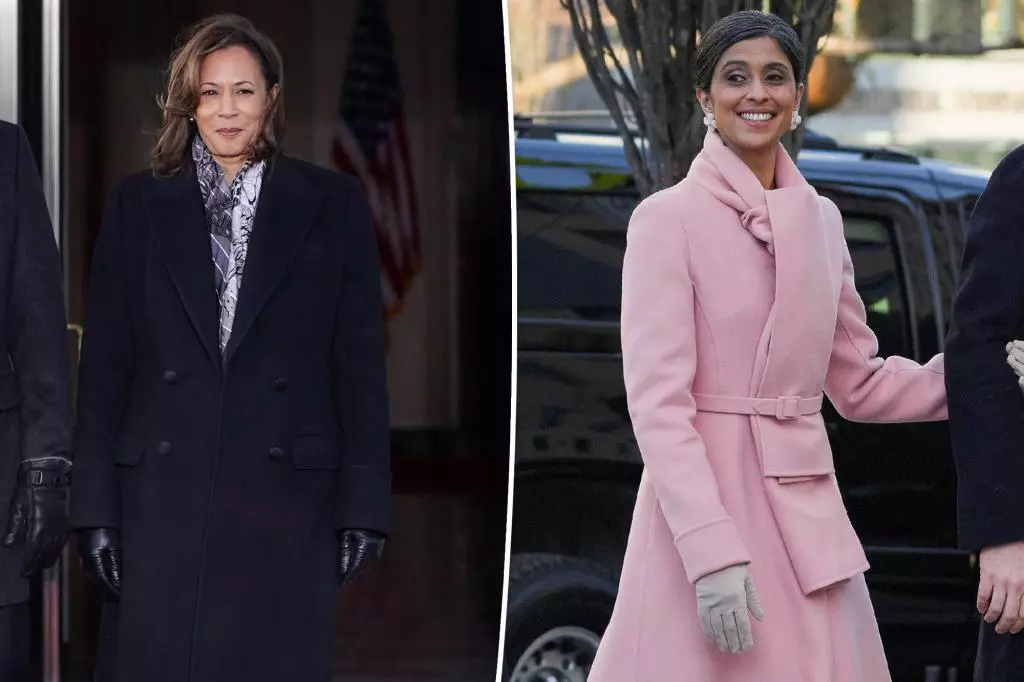In today’s political climate, the intersection of fashion and politics is more significant than ever. Vice President Kamala Harris, as one of the most visible figures in contemporary American politics, has continuously used her wardrobe as a medium for expression and a tool for symbolic messaging. As we delve into her fashion choices, particularly surrounding significant political events like inaugurations, we reveal not only her sartorial preferences but also the larger implications they carry.
Kamala Harris’ participation in President-elect Donald Trump’s inauguration symbolizes not just her commitment to democratic traditions, but also her ability to wield fashion as a vehicle for political narratives. On this noteworthy day, her choice of a tailored black coat and coordinated attire — black trousers, pointed-toe heels, and a deep-hued printed scarf — presented a polished and dignified image. This was more than mere clothing; it was a statement of resilience in the face of electoral defeat and a commitment to an orderly transfer of power. The visual starkness of her classic black ensemble contrasted sharply with Usha Vance’s bubblegum pink attire, highlighting not just individual taste but also a broader narrative on the interpretation of occasion.
Harris has consistently gravitated toward structured silhouettes, often favoring neutral tones that reflect both her professional background and a carefully curated public image. The significance of her fashion choices extends beyond aesthetics. They often evoke a sense of authority and confidence, aligning with her role as a groundbreaking female leader. Each election, each inauguration, serves as a canvas for her to communicate strength through her attire.
One of Harris’s signature accessories — the classic string of pearls — carries rich historical significance that resonates beyond mere fashion. This adornment connects her to the sorority Alpha Kappa Alpha, thereby embracing her cultural heritage. It’s a poignant reminder that in the realm of politics, identity is multifaceted, intertwining personal history, cultural context, and professional aspirations. The pearls represent community, sisterhood, and a legacy that harkens back to the organization’s founders, referred to as the “Twenty Pearls.” By donning this accessory, Harris allows her attire to also serve as a tribute to the women who paved the way for her career.
Moreover, during Joe Biden’s inauguration, she donned a purple ensemble designed by Christopher John Rogers, an indication of her commitment to bipartisanship. This choice not only aligned with traditional colors of power and unity but also underscored her intent to bring together diverse factions of the political landscape through visual symbolism. Such decisions accentuate how fashion can act as a diplomatic tool, fostering goodwill and signaling intentions in a highly polarized environment.
Harris’s style evolution is noteworthy, as is her support for American and particularly Black designers. The “coconut brown” suit by Chloé, which evoked former President Obama’s famous tan suit, merged personal narrative with political commentary, linking her past speeches to her present in the public eye. In this way, her outfits often catalyze discussions that go beyond mere trends to touch upon issues like race, identity, and representation in politics.
Moreover, her choice of LaQuan Smith’s black sequined gown during a Congressional Black Caucus Foundation event was not only a fashion statement but a conscious endorsement of young Black designers. Here, Harris acts as both a fashion icon and a trailblazer, aiming to open doors for others within the creative industry. This commitment not only speaks to her aesthetic preferences but also reflects an understanding of her platform’s potential to foster inclusivity in various spheres.
Kamala Harris embodies the multifaceted nature of modern political life, where fashion and authority coexist in profound ways. Her style choices serve as reminders that clothing can wield power and influence, affecting public perception and political dynamics significantly. In an era where every public appearance can be scrutinized, Harris utilizes her wardrobe not only to assert her identity but also to set cultural precedents that convey unity, resilience, and progress. Through her choices, she challenges the notion of what it means to be a leader in contemporary politics, bridging a gap between fashion and political influence.

